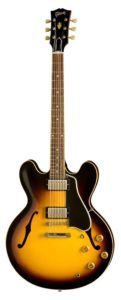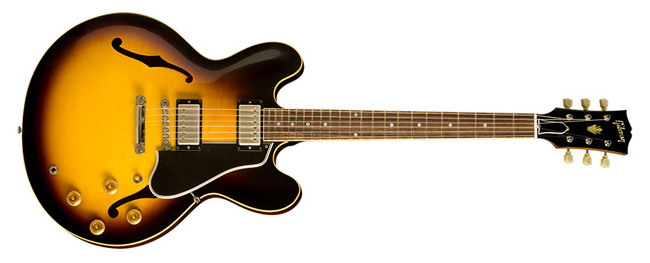
Welcome back to Tech Pan Alley.
Following with our series of articles, we maintain focus at this stage of the signal — In other words, on guitars that are usually seen in the hands of our favourite bluesmasters. Now we are entering in Gibson’s semi-hollow body territory, the ES-335.
Gibson ES-335
There is a difference in the feeling you get when seeing a photograph of a work of art on the web or in a magazine, and when seeing it in real life. It is that sort of feeling you get when you are in the presence of grace and balanced perfection. We are sure that that is exactly the feeling many hard core blues musicos have experienced the first real-life encounter with a Gibson ES-335.
During the early 50’s, Gibson’s production of electric guitars started with the hollow bodys. Then, in the search for an instrument that would not produce as much feedback as the hollow body ones, the solid body guitars arrived (basically the Les Paul, discussed in our last article). Solid body guitars had new tonal qualities such as a distinctive edge and sustain — that the hollow body guitars did not quite produce — and managed to reduce the feedback problem to a fair level. However, solid body guitars lacked the darker and mellow tones that the hollow bodies had. Gibson came up with the great idea of blending the best of both designs and the product, and the ES-335 was introduced in the market in 1958.
The original design, which is essentially the same specs as today, involved a solid center block with laminated maple top and back, mahogany neck, rosewood fretboard with dot or block inlays and the usual Gibson appointments; to mention some, 22 frets, a 17-degrees-angled headstock, three-way toggle switch, and two 57 Classic Humbuckers each with a volume and tone controls.
The 57 Classic humbuckers are the closest recreation by Gibson of their original PAFs. Although the new pickups, compared to the original ones, are hotter, the tones you get from the ES-335 are warm and clear, sweet and mellow with a lot of room to play with the dynamics of the player’s attack – that semi-hollow body certainly plays an important role in nailing “that” tone.
There are upgrades to the “standard” ES-335, which are basically the refined ES-345 and ES-355. These two models are basically the posh relatives of the ES-335 with some added features. Apart from the obvious additional elegant looks, there is the Varitone Control (in all 345s and in some 355s) which, in a nutshell, is a system that filters the frequencies and, depending on the position you have the control on, gives different sounds. The control knob has 6 positions, allowing you to dial in 18 different sounds from your guitar. If you are a fan of B.B. King or Freddie King (also some early Buddy Guy and Luther Allison), you will be familiar with a nasal – sort of choking – sound in their solos,which was created from the artists using the Varitone Control. For more details on the ES-335/345/355 please visit the Gibson website.
Despite these guitars being bank breakers, the actual tones and the playability of the instrument are really inspiring and worth every penny. Coming out of the box, from new, it is difficult to spot any issues or faults. However, as one gets familiar with the instrument, it is clear that a proper set up is often needed and it will come as no surprise that setting up an ES-335 is not cheap! In our experience, from “new”, the ES-335 has required fret levelling, pickguard and pickup height adjustment, and some labour on the guitar intonation. This is definitely something you would not expect from a Custom Shop creation, but it is what it is, and after sorting all out, the playability is amazing. To a certain extent for us at this side of the pond, and to be fair to Gibson’s Custom Shop, the conditions of the inevitable transatlantic voyage from the US to UK may have had impact on the guitar, which is probably why a set up was required.
The electronics on the ES-335 are not easy to modify or replace. You need an expert to do this, otherwise you may never forgive yourself for messing up this expensive beauty.
Useful advice for any ES-335 (or similar semi-hollow body guitar) owners or prospective owners is do not, and we mean NEVER, keep or carry your guitar in a soft case or gig bag. Keep it always in the hard case that comes with or if, it did not come with one, get a good one. We say this because the back of the neck, particularly at the height of the bone nut, is particularly fragile. Also keep your right-hand strumming and any other hazards away from the output jack when a cable is in, otherwise that specific part is, also, prone to break!
As a final advice, we suggest you check out “I’m Going Home” in Ten Years After’s album “Live at The Fillmore East”. Ten Years After’s guitarist and singer, Alvin Lee, is playing a Gibson ES-335 … if you already own one, this song will get you playing. If you do not own one yet, these tunes will get you saving for one.
To end this article we should clarify that, so far as the writer of this column is concerned, the Gibson ES-335 has our vote for “Best Blues Guitar”.
Correction: An image of a Gibson ES-355 and accompanying story title were originally incorrect, indicating that the article was about an ES-355, and have since been updated to reflect the ES-335 subject as the author originally intended.


2 Comments
I play a 1961 es-335 thru a 1951 tv front fender deluxe, or 1985 mesaboogie studio .22 or a just received Blackstar ht-40 club amp and the pig nose .
John, I also play a ES-335 through Blackstar – What setting are you using in the OD channel and on the ISF? Cheers